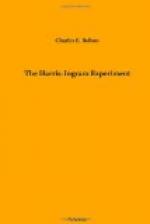One or more of Her Majesty’s armored warships may always be seen within the bay. The “Majestic” dropped anchor in the quiet harbor, and the company’s lighter came along side with passengers for Liverpool, and to take ashore the Queenstown passengers, and the mails which, checked out, numbered over 1600 sacks. The transatlantic mail is put aboard the express and hurried to Dublin, thence from Kingston to Holyhead, via a swift packet across St. George’s Channel, and to its destination, thus saving valuable hours in its delivery throughout Europe.
Several small boats appeared bringing natives who offered for sale fruit, Irish laces, and canes made of black bog oak, with the shamrock carved on the handles. Mrs. Harris was much pleased to renew her acquaintance with the scenes of her girlhood, having sailed from Queenstown for Boston when she was only ten years old.
The baggage was left on the steamer to go forward to Liverpool, and Alfonso led the way aboard the lighter, and from the dock to the Queen’s Hotel. Each carried a small satchel, with change of clothing, till the trunks should be overtaken.
At the hotel Alfonso found the longed-for cablegram from his father which read as follows:—
Harrisville,—
Mrs. Reuben Harris,
Queen’s Hotel, Queenstown, Ireland.
Employees still out. Mills guarded.
Will hire new men. Searles visits
Australia. All well. Enjoy yourselves.
Love.
Reuben Harris.
“It’s too bad that father and Gertrude couldn’t be with us,” said Mrs. Harris.
The lunch ashore of Irish chops, new vegetables, and fruit was a decided improvement on the food of the last few days. The Harrises after a stormy sea voyage were delighted again to put foot on mother earth, to enjoy the green terraces, ivy-clad walls, cottages, and churches, and also to see the shamrock, a tiny clover, which St. Patrick held up before the Irish people to prove the Holy Trinity. Lucille found the pretty yellow furz, the flower which Linnaeus, the famous Swedish botanist, kissed.
Alfonso suggested that they take the part rail and part river route of a dozen miles to Cork, the third city of Ireland. En route are seen beautiful villas, green park-like fields, rich woods, and a terrace that adorns the steep banks of the River Lee. A ruined castle at Monkstown is pointed out, which a thrifty woman built, paying the workman in goods, on which she cleared enough to pay for the castle, except an odd groat, hence the saying, “The castle cost only a groat.”
A delightful day was spent at Cork, an ancient city, which pagans and Danes once occupied, and which both Cromwell and Marlborough captured. Here Rev. Thomas Lee, by his preaching, inclined William Penn, “Father of Pennsylvania,” to become a Quaker. Here was born Sheridan Knowles, the dramatist, and other famous writers.
After visiting the lakes of Killarney and Dublin, the Harris family took a hasty trip through England.




